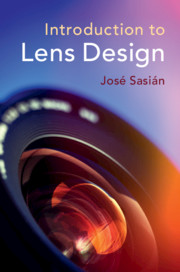Book contents
- Introduction to Lens Design
- Introduction to Lens Design
- Copyright page
- Dedication
- Epigraph
- Contents
- Preface
- 1 Introduction
- 2 Classical Imaging, First-Order Imaging, and Imaging Aberrations
- 3 Aspheric Surfaces
- 4 Thin Lenses
- 5 Ray Tracing
- 6 Radiometry in a Lens System
- 7 Achromatic and Athermal Lenses
- 8 Combinations of Achromatic Doublets
- 9 Image Evaluation
- 10 Lens Tolerancing
- 11 Using Lens Design Software
- 12 Petzval Portrait Objective, Cooke Triplet, and Double Gauss Lens
- 13 Lens System Combinations
- 14 Ghost Image Analysis
- 15 Designing with Off-the-Shelf Lenses
- 16 Mirror Systems
- 17 Miniature Lenses
- 18 Zoom Lenses
- Book part
- Glossary
- Further Reading on Lens Design
- Index
- References
11 - Using Lens Design Software
Published online by Cambridge University Press: 23 September 2019
- Introduction to Lens Design
- Introduction to Lens Design
- Copyright page
- Dedication
- Epigraph
- Contents
- Preface
- 1 Introduction
- 2 Classical Imaging, First-Order Imaging, and Imaging Aberrations
- 3 Aspheric Surfaces
- 4 Thin Lenses
- 5 Ray Tracing
- 6 Radiometry in a Lens System
- 7 Achromatic and Athermal Lenses
- 8 Combinations of Achromatic Doublets
- 9 Image Evaluation
- 10 Lens Tolerancing
- 11 Using Lens Design Software
- 12 Petzval Portrait Objective, Cooke Triplet, and Double Gauss Lens
- 13 Lens System Combinations
- 14 Ghost Image Analysis
- 15 Designing with Off-the-Shelf Lenses
- 16 Mirror Systems
- 17 Miniature Lenses
- 18 Zoom Lenses
- Book part
- Glossary
- Further Reading on Lens Design
- Index
- References
Summary
There are a variety of lens design computer programs. Some of them are CODE V, OpTaliX, OpticStudio, Oslo, and Synopsys. The costs of these programs are two-fold, one for the license to use them, the other for the time the engineer must spend learning to use them, which can be substantial.
Information
- Type
- Chapter
- Information
- Introduction to Lens Design , pp. 126 - 136Publisher: Cambridge University PressPrint publication year: 2019
